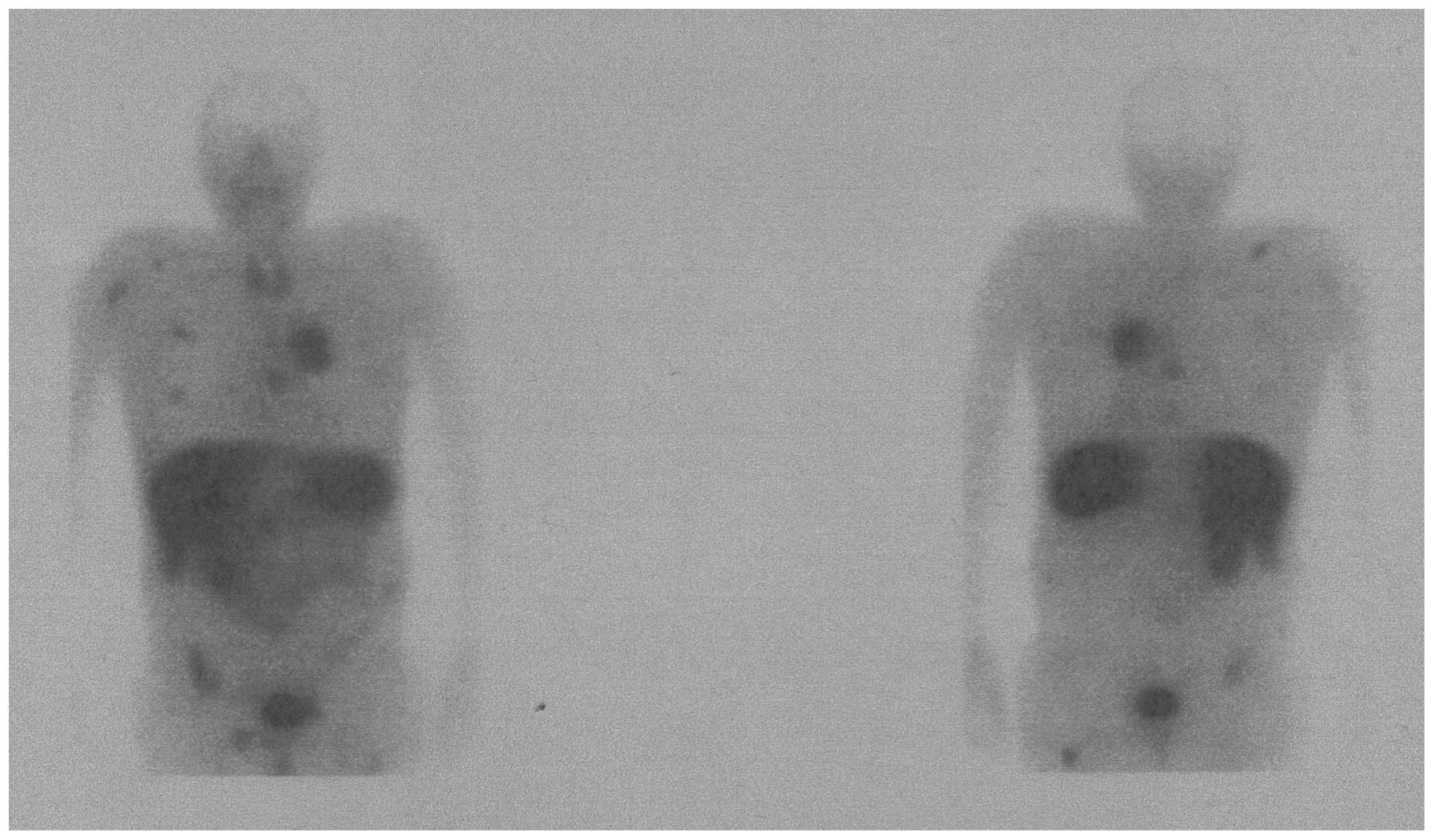|
1
|
Siegel RL, Miller KD and Jemal A: Cancer
statistics, 2015. CA Cancer J Clin. 65:5–29. 2015. View Article : Google Scholar : PubMed/NCBI
|
|
2
|
Humphrey PA: Histological variants of
prostatic carcinoma and their significance. Histopathology.
60:59–74. 2012. View Article : Google Scholar : PubMed/NCBI
|
|
3
|
Terry S and Beltran H: The many faces of
neuroendocrine differentiation in prostate cancer progression.
Front Oncol. 4:602014. View Article : Google Scholar : PubMed/NCBI
|
|
4
|
Nouri M, Ratther E, Stylianou N, Nelson
CC, Hollier BG and Williams ED: Androgen-targeted therapy-induced
epithelial mesenchymal plasticity and neuroendocrine
transdifferentiation in prostate cancer: An opportunity for
intervention. Front Oncol. 4:3702014. View Article : Google Scholar : PubMed/NCBI
|
|
5
|
Matei DV, Renne G, Pimentel M, Sandri MT,
Zorzino L, Botteri E, De Cicco C, Musi G, Brescia A, Mazzoleni F,
et al: Neuroendocrine differentiation in castration-resistant
prostate cancer: A systematic diagnostic attempt. Clin Genitourin
Cancer. 10:164–173. 2012. View Article : Google Scholar : PubMed/NCBI
|
|
6
|
Beltran H, Tagawa ST, Park K, MacDonald T,
Milowsky MI, Mosquera JM, Rubin MA and Nanus DM: Challenges in
recognizing treatment-related neuroendocrine prostate cancer. J
Clin Oncol. 30:e386–e389. 2012. View Article : Google Scholar : PubMed/NCBI
|
|
7
|
Basch E, Loblaw DA, Oliver TK, Carducci M,
Chen RC, Frame JN, Garrels K, Hotte S, Kattan MW, Raghavan D, et
al: Systemic therapy in men with metastatic castration-resistant
prostate cancer: American Society of Clinical Oncology and Cancer
Care Ontario clinical practice guideline. J Clin Oncol.
32:3436–3448. 2014. View Article : Google Scholar : PubMed/NCBI
|
|
8
|
Bousquet C, Lasfargues C, Chalabi M,
Billah SM, Susini C, Vezzosi D, Caron P and Pyronnet S: Clinical
review: Current scientific rationale for the use of somatostatin
analogs and mTOR inhibitors in neuroendocrine tumor therapy. J Clin
Endocrinol Metab. 97:727–737. 2012. View Article : Google Scholar : PubMed/NCBI
|
|
9
|
Keskin O and Yalcin S: A review of the use
of somatostatin analogs in oncology. Onco Targets Ther. 6:471–483.
2013.PubMed/NCBI
|
|
10
|
Zhu S, Oremo JA, Li S, Zhen M, Tang Y and
Du Y: Synergistic antitumor activities of docetaxel and octreotide
associated with apoptotic-upregulation in castration-resistant
prostate cancer. PLoS One. 9:e918172014. View Article : Google Scholar : PubMed/NCBI
|
|
11
|
Mencobonii M, Tredici S, Rebella L,
Bergaglio M, Galbusera V, Manzara A, Claudiani F, Malcangi B and
Varaldo M: Effect of chemotherapy on somatostatin receptor
detection with octreotide scintigraphy in hormone-refractory
prostate cancer patients. Anticancer Res. 26:2233–2235.
2006.PubMed/NCBI
|
|
12
|
Nilsson S, Reubi JC, Kalkner KM, Laissue
JA, Horisberger U, Olerud C and Westlin JE: Metastatic
hormone-refractory prostatic adenocarcinoma expresses somatostatin
receptors and is visualized in vivo by (111In)-labeled
DTPA-D-(Phe1)-octreotide scintigraphy. Cancer Res.
55(Suppl 23): 5805s–5810s. 1995.PubMed/NCBI
|
|
13
|
Krenning EP, Kwekkeboom DJ, Bakker WH,
Breeman WA, Kooij PP, Oei HY, van Hagen M, Postema PT, de Jong M,
Reubi JC, et al: Somatostatin receptor scintigraphy with
(111In-DTPA-D-Phe1)-and
(123I-Tyr3)-octreotide: The Rotterdam
experience with more than 1,000 patients. Eur J Nucl Med.
20:716–731. 1993. View Article : Google Scholar : PubMed/NCBI
|
|
14
|
Herlin G, Kölbeck KG, Menzel PL, Svensson
L, Aspelin P, Capitanio A and Axelsson R: Quantitative assessment
of 99mTc-depreotide uptake in patients with
non-small-cell lung cancer: Immunohistochemical correlations. Acta
Radiol. 50:902–908. 2009. View Article : Google Scholar : PubMed/NCBI
|
|
15
|
Lattanzio L, Tonissi F, Monteverde M,
Milano G, Merlano MC and Lo Nigro C: Differential molecular
mechanism of docetaxel-octreotide combined treatment according to
the docetaxel-resistance status in PC3 prostate cancer cells.
Anticancer Drugs. 24:120–130. 2013. View Article : Google Scholar : PubMed/NCBI
|















